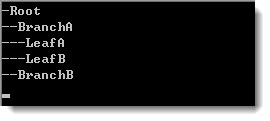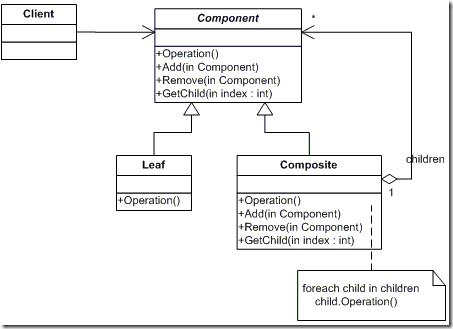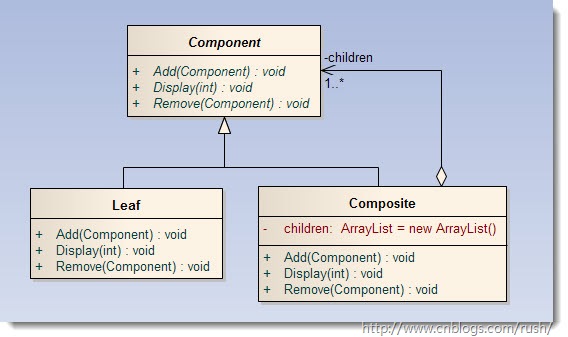设计模式(2) ------------组合模式
来源:互联网 发布:淘宝兼职旺旺客服 编辑:程序博客网 时间:2024/05/16 08:02
1.1.1 摘要
在软件系统设计中,我们经常会遇到整体和部分的设计问题,例如为一家架构完善的公司设计系统时,我们在系统设计过程中应该更加注重这种整体和部分的关系(总部和分部的关系),这就是我们今天要介绍的组合模式(Composite)。
组合模式(Composite)把对象构造成为一棵对象树,现在让我们简短回忆一下树的定义。
树是一种数据结构,它是由n(n>=1)个有限结点组成一个具有层次关系的集合。把它叫做“树”是因为它看起来像一棵倒挂的树,也就是说它是根朝上,而叶朝下的。它具有以下的特点:
每个结点有零个或多个子结点;
每一个子结点只有一个父结点;
没有前驱的结点为根结点;
除了根结点外,每个子结点可以分为m个不相交的子树(参考维基百科);
- 定义
组合模式(Composite),将对象组合成树形结构以表示‘部分-整体’的层次关系(树状结构)。组合模式使得用户对单个对象和组合对象使用具有一致性。
- 意图
希望用户可以忽略单个对象和组合对象的区别,统一使用组合结构中的所有对象(封装变化的思想)。
- 结构图

图1组合模式(Composite)结构图
- 参与者
Component
它是一个抽象角色,为对象的组合提供统一的接口。
为其派生类提供默认的行为。
通过该接口来访问和管理Child Components(节点后继)。
通过该接口来访问Parent Components(节点前驱)。
Leaf
代表参加组合的叶子对象(叶子没有后继)。
定义组成原始对象的行为。
Composite
定义非叶子对象的行为。
实现Component中的孩子操作行为(如:Add(),Remove() 等)。
1.1.2 正文
在我们学习组合模式(Composite)之前,让我们先讲解一下透明方式和安全方式。
透明方式:在Component中声明所有用来管理子对象的方法,如Add()方法,Remove()方法及GetChild()方法,所有实现Component接口的子类都具备这些方法,这使得Component和子类具备一致的行为接口,使得对客户端无需区别树叶和树枝对象。
大家可以回忆一下代理模式(Proxy)中,Proxy,RealSubject类和Subject接口具备一致的行为接口,从而使得被代理者对于客户端是透明的。
正由于我们的Composite和Leaf都具备一致的接口行为,但我们知道Leaf不应该具有Add(),Remove()及GetChild()方法,因为我们叶子节点不能再添加和移除节点了。
安全模式:在透明模式基础上把Component中声明所有用来管理子对象的方法移到Composite中,在Composite实现子对象的管理方法,那么Leaf就没有子对象管理方法,这使得Composite和Leaf的行为接口不一致,所以客户端在调用时要知道树叶和树枝对象存在。

图2透明方式的组合模式(Composite)结构图

图3安全方式的组合模式(Composite)结构图
通过前面的介绍我们知道透明和安全方式组合模式(Composite)的区别在于是否在抽象接口Component中定义子对象的管理行为。现在让我们完成透明方式的组合模式(Composite)。
以下示例代码演示透明方式的组合模式代码:
首先我们定义一个抽象类Componet,在其中声明Add(),Remove()和Display()等子对象操作发法及初始化字段name的公共行为。
/// <summary>/// The Component acts as abstract class./// </summary>public abstract class Component{ protected string name; public Component() { } public Component(string name) { this.name = name; } #region Methods public abstract Component Add(Component obj); public abstract void Remove(Component obj); public abstract void Display(int depth); #endregion}
接着我们定义Composite类继承于Component,增加_children保存Component对象的引用,从而建立起由Component到Composite的聚集关系(Has-a关系),并且实现Component抽象类中的抽象方法。
/// <summary>/// The Composite acts as branch./// </summary>public class Composite : Component{ private IList<Component> _childen = new List<Component>(); public Composite() { } public Composite(string name) : base(name) { } /// <summary> /// Adds the branch or leaf obj. /// </summary> /// <param name="obj">The obj.</param> /// <returns></returns> public override Component Add(Component obj) { this._childen.Add(obj); return obj; } /// <summary> /// Removes the branch or leaf obj. /// </summary> /// <param name="obj">The obj.</param> public override void Remove(Component obj) { this._childen.Remove(obj); } /// <summary> /// Displays the tree's depth. /// </summary> /// <param name="depth">The depth.</param> public override void Display(int depth) { StringBuilder depthBuilder = new StringBuilder(new String('-', depth) + name); Console.WriteLine(depthBuilder); foreach (Component child in _childen) { child.Display(depth + 1); } }}
最后我们定义Leaf类它也是继承于Component,在其中我们实现Component定义的行为接口,这使得Composite和Leaf类具有统一的接口行为,但我们并没有在Leaf的行为方法中给出具体的实现,因为叶子节点并没有后继,所以没有必要实现Add()和Remove()等行为。
/// <summary>/// The "Leaf" acts as Leaf./// </summary>public class Leaf : Component{ public Leaf(string name) : base(name) { } public Leaf() { } /// <summary> /// Adds the branch or leaf obj. /// </summary> /// <param name="obj">The obj.</param> /// <returns></returns> public override Component Add(Component obj) { throw new NotSupportedException(); } /// <summary> /// Removes the branch or leaf obj. /// </summary> /// <param name="obj">The obj.</param> public override void Remove(Component obj) { throw new NotSupportedException(); } /// <summary> /// Displays the tree's depth. /// </summary> /// <param name="depth">The depth.</param> public override void Display(int depth) { StringBuilder depthBuilder = new StringBuilder(new String('-', depth) + name); Console.WriteLine(depthBuilder); }}
我们定义一个工厂方法来创建Composite和Leaf对象,大家可以注意到在创建一个Component对象之后,我们调用子对象管理方法时,并不需要判断当前对象是由Composite类,还是有Leaf类创建得来,这就是透明方式的组合模式(Composite)。
public class Program{ static void Main(string[] args) { Client client = new Client(); Component component = client.Get("root"); Component componentA = component.Add(new Composite("BranchA")); componentA.Add(new Leaf("LeafA")); componentA.Add(new Leaf("LeafB")); Component componentB = component.Add(new Composite("BranchB")); component.Display(1); Console.ReadKey(); }}

图4输出结果
前面例子给出了透明方式组合模式(Composite)的实现,我们在Component中声明了Add() 和Remove()操作子对象方法,使得Composite和Leaf类具备一致的行为接口,客户端可以正常调用Composite中的操作子对象方法,但如果客户端尝试调用Leaf中操作子对象方法时会抛出异常,因为叶子节点没有后继节点了,假设我们要实现安全方式组合模式(Composite)客户端在调用操作子对象方法时,需要判断当前对象是叶子节点或枝节点。
Component component = client.Get("root");if (component is Composite){ //// Implemention code.}
接下来让我们通过绘图程序实例,介绍安全方式的组合模式(Composite)的实现,首先我们定义一个抽象类DrawingProgramm,其角色为Component,然后再添加三个子类Shape,Triangle和Circle,它们的角色分别为:Composite,Leaf和Leaf。
现在把子对象的管理方法都移到Shape类中,所以对客户端来说调用子对象时,它了解Shape、Triangle和Circle直接的区别。
以下示例代码演示安全方式的组合模式代码:
首先我们定义一个抽象类DrawingProgramming(即Componet),在其中声明Draw()及初始化字段_name的公共行为。
/// <summary>/// The "DrawingProgramming" class acts as component./// </summary>public abstract class DrawingProgramming{ protected string _name; public abstract void Draw(); public DrawingProgramming(string name) { this._name = name; }}
接着我们定义Shape类继承于DrawingProgramming,增加_children保存DrawingProgramming对象的引用,也是建立起由DrawingProgramming到Shape的聚集关系(Has-a关系),大家要注意到安全方式的组合模式(Composite)对子对象的管理方法都移到Shape类(即Composite)中,使得Leaf和Composite的行为接口不一致。
/// <summary>/// The "Shape" class acts as composite./// </summary>public class Shape : DrawingProgramming{ IList<DrawingProgramming> _children = new List<DrawingProgramming>(); public Shape(string name) : base(name) { } #region DrawingProgramming 成员 public override void Draw() { StringBuilder depthBuilder = new StringBuilder(_name); Console.WriteLine(depthBuilder); foreach (DrawingProgramming child in _children) { child.Draw(); } } #endregion #region Methods public void Add(DrawingProgramming dp) { _children.Add(dp); } public void Remove(DrawingProgramming dp) { _children.Remove(dp); } #endregion}
最后我们定义Triangle和Circle类它也是继承于DrawingProgramming,在其中我们实现DrawingProgramming定义的Draw()行为,这使得Composite和Leaf类具有不一致的接口行为,这样我们可以避免在Leaf中实现没有必要地接口,从而使得我们设计符合SRP原则(对象职责单一原则)。
/// <summary>/// The "Triangle" class acts as leaf./// </summary>public class Triangle : DrawingProgramming{ public Triangle(string name) : base(name) { } #region DrawingProgramming 成员 public override void Draw() { StringBuilder depthBuilder = new StringBuilder(_name); Console.WriteLine(depthBuilder); } #endregion}/// <summary>/// The "Circle" class acts as leaf./// </summary>public class Circle : DrawingProgramming{ public Circle(string name) : base(name) { } #region DrawingProgramming 成员 public override void Draw() { StringBuilder depthBuilder = new StringBuilder(_name); Console.WriteLine(depthBuilder); } #endregion}
- 定义
组合模式(Composite),将对象组合成树形结构以表示‘部分-整体’的层次关系(树状结构)。组合模式使得用户对单个对象和组合对象使用具有一致性。
- 意图
希望用户可以忽略单个对象和组合对象的区别,统一使用组合结构中的所有对象(封装变化的思想)。
- 结构图

图1组合模式(Composite)结构图
- 参与者
Component
它是一个抽象角色,为对象的组合提供统一的接口。
为其派生类提供默认的行为。
通过该接口来访问和管理Child Components(节点后继)。
通过该接口来访问Parent Components(节点前驱)。
Leaf
代表参加组合的叶子对象(叶子没有后继)。
定义组成原始对象的行为。
Composite
定义非叶子对象的行为。
实现Component中的孩子操作行为(如:Add(),Remove() 等)。
1.1.2 正文
在我们学习组合模式(Composite)之前,让我们先讲解一下透明方式和安全方式。
透明方式:在Component中声明所有用来管理子对象的方法,如Add()方法,Remove()方法及GetChild()方法,所有实现Component接口的子类都具备这些方法,这使得Component和子类具备一致的行为接口,使得对客户端无需区别树叶和树枝对象。
大家可以回忆一下代理模式(Proxy)中,Proxy,RealSubject类和Subject接口具备一致的行为接口,从而使得被代理者对于客户端是透明的。
正由于我们的Composite和Leaf都具备一致的接口行为,但我们知道Leaf不应该具有Add(),Remove()及GetChild()方法,因为我们叶子节点不能再添加和移除节点了。
安全模式:在透明模式基础上把Component中声明所有用来管理子对象的方法移到Composite中,在Composite实现子对象的管理方法,那么Leaf就没有子对象管理方法,这使得Composite和Leaf的行为接口不一致,所以客户端在调用时要知道树叶和树枝对象存在。

图2透明方式的组合模式(Composite)结构图

图3安全方式的组合模式(Composite)结构图
通过前面的介绍我们知道透明和安全方式组合模式(Composite)的区别在于是否在抽象接口Component中定义子对象的管理行为。现在让我们完成透明方式的组合模式(Composite)。
以下示例代码演示透明方式的组合模式代码:
首先我们定义一个抽象类Componet,在其中声明Add(),Remove()和Display()等子对象操作发法及初始化字段name的公共行为。
/// <summary>/// The Component acts as abstract class./// </summary>public abstract class Component{ protected string name; public Component() { } public Component(string name) { this.name = name; } #region Methods public abstract Component Add(Component obj); public abstract void Remove(Component obj); public abstract void Display(int depth); #endregion}
接着我们定义Composite类继承于Component,增加_children保存Component对象的引用,从而建立起由Component到Composite的聚集关系(Has-a关系),并且实现Component抽象类中的抽象方法。
/// <summary>/// The Composite acts as branch./// </summary>public class Composite : Component{ private IList<Component> _childen = new List<Component>(); public Composite() { } public Composite(string name) : base(name) { } /// <summary> /// Adds the branch or leaf obj. /// </summary> /// <param name="obj">The obj.</param> /// <returns></returns> public override Component Add(Component obj) { this._childen.Add(obj); return obj; } /// <summary> /// Removes the branch or leaf obj. /// </summary> /// <param name="obj">The obj.</param> public override void Remove(Component obj) { this._childen.Remove(obj); } /// <summary> /// Displays the tree's depth. /// </summary> /// <param name="depth">The depth.</param> public override void Display(int depth) { StringBuilder depthBuilder = new StringBuilder(new String('-', depth) + name); Console.WriteLine(depthBuilder); foreach (Component child in _childen) { child.Display(depth + 1); } }}
最后我们定义Leaf类它也是继承于Component,在其中我们实现Component定义的行为接口,这使得Composite和Leaf类具有统一的接口行为,但我们并没有在Leaf的行为方法中给出具体的实现,因为叶子节点并没有后继,所以没有必要实现Add()和Remove()等行为。
/// <summary>/// The "Leaf" acts as Leaf./// </summary>public class Leaf : Component{ public Leaf(string name) : base(name) { } public Leaf() { } /// <summary> /// Adds the branch or leaf obj. /// </summary> /// <param name="obj">The obj.</param> /// <returns></returns> public override Component Add(Component obj) { throw new NotSupportedException(); } /// <summary> /// Removes the branch or leaf obj. /// </summary> /// <param name="obj">The obj.</param> public override void Remove(Component obj) { throw new NotSupportedException(); } /// <summary> /// Displays the tree's depth. /// </summary> /// <param name="depth">The depth.</param> public override void Display(int depth) { StringBuilder depthBuilder = new StringBuilder(new String('-', depth) + name); Console.WriteLine(depthBuilder); }}
我们定义一个工厂方法来创建Composite和Leaf对象,大家可以注意到在创建一个Component对象之后,我们调用子对象管理方法时,并不需要判断当前对象是由Composite类,还是有Leaf类创建得来,这就是透明方式的组合模式(Composite)。
public class Program{ static void Main(string[] args) { Client client = new Client(); Component component = client.Get("root"); Component componentA = component.Add(new Composite("BranchA")); componentA.Add(new Leaf("LeafA")); componentA.Add(new Leaf("LeafB")); Component componentB = component.Add(new Composite("BranchB")); component.Display(1); Console.ReadKey(); }}

图4输出结果
前面例子给出了透明方式组合模式(Composite)的实现,我们在Component中声明了Add() 和Remove()操作子对象方法,使得Composite和Leaf类具备一致的行为接口,客户端可以正常调用Composite中的操作子对象方法,但如果客户端尝试调用Leaf中操作子对象方法时会抛出异常,因为叶子节点没有后继节点了,假设我们要实现安全方式组合模式(Composite)客户端在调用操作子对象方法时,需要判断当前对象是叶子节点或枝节点。
Component component = client.Get("root");if (component is Composite){ //// Implemention code.}
接下来让我们通过绘图程序实例,介绍安全方式的组合模式(Composite)的实现,首先我们定义一个抽象类DrawingProgramm,其角色为Component,然后再添加三个子类Shape,Triangle和Circle,它们的角色分别为:Composite,Leaf和Leaf。
现在把子对象的管理方法都移到Shape类中,所以对客户端来说调用子对象时,它了解Shape、Triangle和Circle直接的区别。
以下示例代码演示安全方式的组合模式代码:
首先我们定义一个抽象类DrawingProgramming(即Componet),在其中声明Draw()及初始化字段_name的公共行为。
/// <summary>/// The "DrawingProgramming" class acts as component./// </summary>public abstract class DrawingProgramming{ protected string _name; public abstract void Draw(); public DrawingProgramming(string name) { this._name = name; }}
接着我们定义Shape类继承于DrawingProgramming,增加_children保存DrawingProgramming对象的引用,也是建立起由DrawingProgramming到Shape的聚集关系(Has-a关系),大家要注意到安全方式的组合模式(Composite)对子对象的管理方法都移到Shape类(即Composite)中,使得Leaf和Composite的行为接口不一致。
/// <summary>/// The "Shape" class acts as composite./// </summary>public class Shape : DrawingProgramming{ IList<DrawingProgramming> _children = new List<DrawingProgramming>(); public Shape(string name) : base(name) { } #region DrawingProgramming 成员 public override void Draw() { StringBuilder depthBuilder = new StringBuilder(_name); Console.WriteLine(depthBuilder); foreach (DrawingProgramming child in _children) { child.Draw(); } } #endregion #region Methods public void Add(DrawingProgramming dp) { _children.Add(dp); } public void Remove(DrawingProgramming dp) { _children.Remove(dp); } #endregion}
最后我们定义Triangle和Circle类它也是继承于DrawingProgramming,在其中我们实现DrawingProgramming定义的Draw()行为,这使得Composite和Leaf类具有不一致的接口行为,这样我们可以避免在Leaf中实现没有必要地接口,从而使得我们设计符合SRP原则(对象职责单一原则)。
/// <summary>/// The "Triangle" class acts as leaf./// </summary>public class Triangle : DrawingProgramming{ public Triangle(string name) : base(name) { } #region DrawingProgramming 成员 public override void Draw() { StringBuilder depthBuilder = new StringBuilder(_name); Console.WriteLine(depthBuilder); } #endregion}/// <summary>/// The "Circle" class acts as leaf./// </summary>public class Circle : DrawingProgramming{ public Circle(string name) : base(name) { } #region DrawingProgramming 成员 public override void Draw() { StringBuilder depthBuilder = new StringBuilder(_name); Console.WriteLine(depthBuilder); } #endregion}
转载自:http://www.cnblogs.com/rush/archive/2011/07/10/2102288.html
- 设计模式(2) ------------组合模式
- 组合设计模式2
- 设计模式:组合模式
- 设计模式-----组合模式
- 设计模式 组合模式
- 设计模式--组合模式
- 设计模式---组合模式
- 【设计模式】组合模式
- 设计模式 - 组合模式
- 设计模式----组合模式
- 设计模式 - 组合模式
- 设计模式:组合模式
- 设计模式 - 组合模式
- 设计模式-组合模式
- 设计模式 - 组合模式
- 【设计模式】组合模式
- 设计模式--组合模式
- 设计模式-组合模式
- Lock-Free Data Structures
- Android的AlertDialog详解
- JAVA中转义字符
- COM 组件设计与应用(七)——编译、注册、调用
- Boot Loader分析
- 设计模式(2) ------------组合模式
- VI下删除文本中的^M
- hdu1171 http://acm.hdu.edu.cn/showproblem.php?pid=1171
- Ubuntu 12.10 x86 安装Flash插件方法
- js客户端检测
- 通向架构师的道路(第一天)之Apache整合Tomcat
- Video4Linux 视频设备数据结构的定义
- 输入数字求对应的月份(英文)
- PHP解析URL并得到URL中的参数


